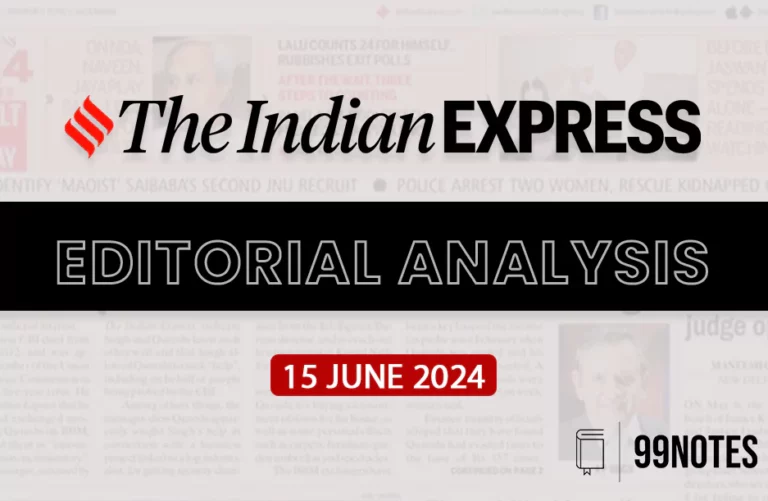30 Dec 2023 : Indian Express
Indian Express
30- December-2023
1. A PATCHY CLIMATE REPORT
| Topic: GS3 – Environment– Environmental pollution and degradation, Environmental impact assessment. This topic is not much relevant in the context of Prelims but more for Mains in the context of complexities and challenges surrounding global climate commitments. |
| Context: |
|
Global Temperature Projections:
- Even if all of this year’s commitments are fulfilled, the UN projects a rise in temperature of 2.5 to 2.9 degrees Celsius.
- Given that the world is expected to rise above the 1.5 degree Celsius limit set at COP21 in Paris eight years ago, this presents a serious issue.
Per Capita Emissions and Country Contributions:
- Sharp differences can be seen when per capita emissions from the Rio Earth Summit are analysed.
- Between 1992 and 2019, the average American produced around 700 tonnes of greenhouse gases, which is more than three times the amount produced globally.
- China must deal with growing emissions from ongoing coal-fired power plant building, while the US must surpass its carbon reduction promises in order to reach climate targets.
Global Emission Contributions:
- With varying degrees of commitment, the G20 countries accounted for 74% of world emissions in 2021.
- Russia hasn’t taken any major steps to reduce emissions, but the EU, Japan, Canada, South Korea, and the UK are actively working to reduce pollution.
Unique Challenges of India, Brazil, and Indonesia:
- With 19% of GHG emissions coming from Brazil, Indonesia, and India, these countries confront particular difficulties because of their relatively small historical contributions to global warming.
- It is unjust to expect these nations to drastically reduce their use of fossil fuels.
- It is recommended that strong nations set high goals and encourage others to do the same.
Economic Viability of Coal and the Role of Natural Gas:
- The cost-competitiveness of renewable energy sources is making coal less economically viable.
- The COP28 language, however, highlights natural gas as a vital bridge fuel while ignoring the substantial role that methane—the main ingredient in natural gas plays in the present warming trend.
- India can contribute to the urgent need to reduce methane emissions by using technology advancements and better water management practices.
India’s Role and Achievements:
- India has made a substantial contribution to the development of the climate discourse by highlighting issues of energy availability, equity, and climate justice.
- The nation has met its 2030 targets ahead of schedule and has cut its emission intensity by 33 percent.
- Aligning policy with sustainable development is still difficult, though.
Hope Amid Challenges:
- There is optimism for the future of COP conferences in the form of global financial support, technical improvements, and national moral pressure.
- But even these might not be enough to prevent a global climate catastrophe, which is why international leaders must work towards stronger pledges.
Conclusion:
- In order to address the approaching climate problem, states are urged to take meaningful action rather than just symbolic gestures, as the analysis highlights the intricacies and difficulties underlying global climate obligations.
| What are the Key Outcomes of COP 28 (2023)? |
Global Stocktake Text:
Transitioning Away from Fossil Fuels:
Global Goal on Adaptation (GGA):
Climate Finance:
Loss and Damage Fund:
Global Renewables and Energy Efficiency Pledge:
The Global Cooling Pledge for COP 28:
Declaration to Triple Nuclear Energy:
|
| PYQ: Describe the major outcomes of the 26th session of the Conference of the Parties (COP) to the United Nations Framework Convention on Climate Change (UNFCCC). What are the commitments made by India in this conference? (250 words/15m) (UPSC CSE (M) GS-3 2021) |
| Practice Question: Discuss the key challenges and complexities highlighted in the context of India’s stance and global commitments at COP28. (200 words/12.5 m) |
2. Press pause and process
| Topic: GS3 – Science and technology This topic is not much relevant in the context of Prelims but more for Mains in the context of challenges in the age of AI |
| Context: |
|
Positive Aspects and Concerns:
- Prime Minister Modi acknowledged the benefits of AI but voiced concerns about its possible misuse, noting problems including data theft, cybersecurity risks, deepfakes, and terrorists’ potential use of AI tools.
- An era where machines, led by machine learning, surpass human intelligence has been brought about by the fast expansion of artificial intelligence, big data, and robotics.
- This has caused considerable fear.
Global Response and Skepticism:
- Prominent global identities, like Elon Musk, have voiced doubts regarding uncontrolled AI trials and called for a brief stop to address grave concerns.
- A discussion on AI ethics was held in the Vatican, and the outcome was the “Rome Call for AI Ethics,” which emphasised the need of responsible AI development and moral algorithms.
- Microsoft and IBM executives echoed the demand for a human-centric strategy, highlighting the moral use of AI to support human brilliance and creativity.
G-20 Summit and Delhi Declaration:
- The Delhi Declaration, which was unveiled at the G-20 Summit in September, emphasised the need for “Responsible Human-Centric AI” and the establishment of an international framework to stop the abuse of AI.
- In order to safeguard mankind, Prime Minister Modi demanded swift action, urging all nations to cooperate and complete the global framework within a given time frame.
Pope Francis’s Concerns:
- Pope Francis voiced concerns about the possible effects of AI advancements on justice, harmony, and peace in his New Year’s speech.
- He emphasised the need to uphold core human values in the face of AI’s profound effects and posed pressing ethical considerations about the use of digital technology.
Meta Era and Ethical Foundations:
- The article examines how religion and reason have driven human progress throughout history, with reason’s greatest obstacle coming from the development of artificial intelligence.
- In the past, philosophical and moral frameworks followed scientific breakthroughs; in contrast, the current Meta age does not have such an intervention.
- Global leaders are being urged to consider the ethical implications of artificial intelligence (AI) by leaders like Pope Francis and Prime Minister Modi, who emphasise the significance of “algorethics” or the ethics of AI.
Conclusion:
- As we move towards a future in which artificial intelligence-powered machine minds play a major role, ethical issues become more important than ever.
- Leaders in politics and religion are requesting a global commitment to responsible and human-centered development, as well as a pause to consider the ethical implications of artificial intelligence.
- The article emphasises how urgent it is for everyone to work together to shape AI’s ethical underpinnings in order to guarantee that they are consistent with key human values.
| What is GPAI? |
About:
At present, GPAI has twenty-five member states:
The founding members are:
|
| PYQ: With the present state of development, Artificial Intelligence can effectively do which of the following? (2020) Bring down electricity consumption in industrial units Create meaningful short stories and songs Disease diagnosis Text-to-Speech Conversion Wireless transmission of electrical energy Select the correct answer using the code given below: (a) 1, 2, 3 and 5 only (b) 1, 3 and 4 only (c) 2, 4 and 5 only (d) 1, 2, 3, 4 and 5 Ans: (b) |
| Practice Question: Discuss the global concerns and ethical considerations associated with the rise of Artificial Intelligence (AI). (200 words/12.5 m) |
For Enquiry

30 Dec 2023 : Indian Express

30 Dec 2023 : PIB

30 Dec 2023 : Daily Current Affairs

30 December 2023 : The Hindu Editorial Notes PDF

WHO Full Form, Origin & Functions

29 Dec 2023 : Daily Quiz

29 Dec 2023 : Daily Answer Writing

29 December 2023 : The Hindu Editorial Notes PDF

29 Dec 2023 : PIB

29 Dec 2023 : Indian Express
december 2023 indian express 30 Dec 2023 : Indian Express Indian Express
29- December-2023
1. NOT ZERO SUM
Topic: GS2 – International Relations- Bilateral…
December 2023 Pib 30 Dec 2023 : PIB PRESS INFORMATION BUREAU
30-December -2023
1. Year End Review of Department of Space.
Topic: GS2…
Daily Current Affairs 30 Dec 2023 : Daily Current Affairs Daily Current Affairs
30-December-2023
1. 11th century Jain sculptures discovered in Mysuru district.
Topic:…
December 2023 The Hindu 30 December 2023 : The Hindu Editorial Notes PDF The Hindu Editorial
30-December-2023
1. A call for disability inclusion that must be needed.
Topic:…
Full Form WHO Full Form, Origin & Functions The full form of WHO is “World Health Organisation”. At the moment, the world is dealing with a slew…
Daily Quiz 29 Dec 2023 : Daily Quiz 29 Dec 2023 : Daily Quiz…
mains answer writing 29 Dec 2023 : Daily Answer Writing Mains Answer Writing
29-December-2023
1. “The fall of the Berlin Wall in 1989 signaled the end…
December 2023 The Hindu 29 December 2023 : The Hindu Editorial Notes PDF The Hindu Editorial
29-December-2023
1. India’s stationary course in the shipping value chain.
Topic:…
December 2023 Pib 29 Dec 2023 : PIB PRESS INFORMATION BUREAU
29-December -2023
1. Ministry of Corporate Affairs Year Ender 2023
Topic:…
december 2023 indian express 29 Dec 2023 : Indian Express Indian Express
29- December-2023
1. NOT ZERO SUM
Topic: GS2 – International Relations- Bilateral…




